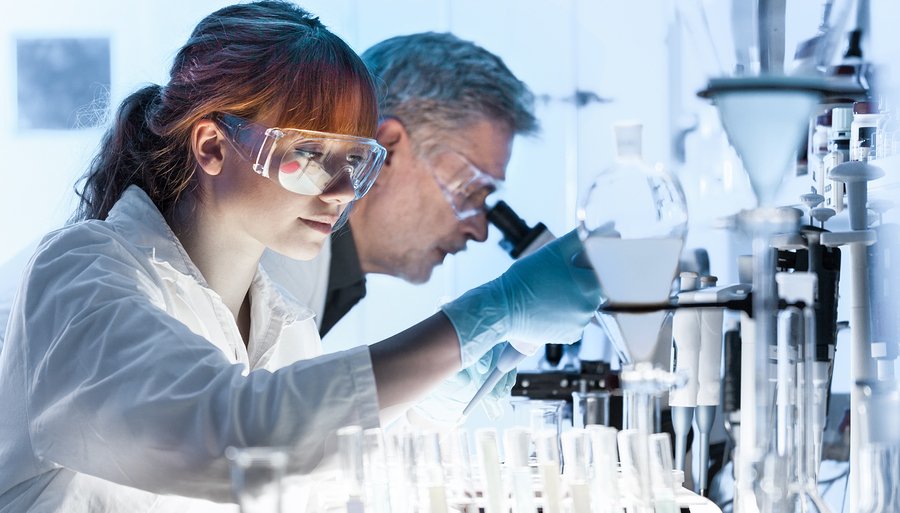Think it couldn’t get much more bizarre than Steve Martin falling in love with a disembodied cerebrum in his Man with Two Brains flick? Well, think again: here’s a case where truth is even stranger than fiction.
In the past few years, scientists have figured out how to grow mini human brains from scratch. While it’s “mind-blowing” to know that in labs across the globe brains are being reared, the more startling development is that some of those brains have been successfully implanted into various non-human critters.1 Hess, Peter. “Human Mini-Brains Growing Inside Rat Bodies Are Starting To Integrate.” 8 November 2017. Inverse Science. 20 December 2017. http://www.inverse.com/article/38240-mini-brains-organoids-rats Into mice, for instance. Perhaps the idea of a talking Micky Mouse isn’t that farfetched after all.
The whole thing got going back in 2015 at Ohio State University, when researchers built a primitive version of a brain, which they called a “brain organoid”2 Patterson, Thom. “Human mini-brains grown in labs may help solve cancer, autism, Alzheimer’s.” 22 October 2015. CNN. 20 December 2017. www.cnn.com/2015/10/06/health/pioneers-brain-organoids/index.html (an artificially grown mass of cells or tissue that resembles a mini-brain). These first simple organoids were only a few millimeters long and consisted of skin cells converted into brain cells, but researchers saw the potential. Within a few years, the Ohio State researchers had an organoid containing 98% of the types of cells comprising a five-week-old human fetal brain.
“It not only looks like the developing brain, its diverse cell types express nearly all genes like a brain,” said the lead researcher, Dr. Rene Anand, at the time, noting that the brain included a cerebral hemisphere and structures to control a spinal cord and retina.3 “Human Brain Grown in Lab Could Be Most Complete Yet.” The Guardian. 21 December 2017. www.iflscience.com/brain/human-brain-grown-lab-most-complete-yet
Since then, progress has continued at lightning speed with researchers worldwide hopping on the bandwagon. The researchers underline the fact that human mini-brains afford an extraordinary opportunity to conduct research on brain function and disease, one that far surpasses what can be accomplished using animal brains. Using these tiny brains, for instance, they’re planning to investigate what causes Alzheimer’s and what drugs or interventions slow or even halt the progression of the disease. According to a CNN report, “Scientists would use [the brain organoids] to mimic human brains deteriorating from Alzheimer’s or Parkinson’s and then study how they react to innovative treatments or newly developed drugs.” The big challenge right now, say the researchers, is to find a way to accelerate aging in the organoids so they’re ready for such research.
Other studies already are well underway using the brain organoids, including explorations in Brazil investigating the effects of psychedelics and other intoxicants.4 Frankel, Joseph. “Scientists Grow Human Mini-Brains in Lab and Then Dose Them with Psychedelic Drugs.” 9 October 2017. “ Newsweek. 21 December 2017. http://www.newsweek.com/scientists-grow-human-minibrains-lab-then-test-psychedelic-drugs-680039 A piece in the journal Scientific Reports explains that unlike Timothy Leary—the ousted Harvard psychedelics researcher who famously advised followers in the 60’s to “turn on, tune in, drop out”—the Brazilian scientists started by first growing a batch of brains, then dividing those brains into three groups. The first group of brains were used as a control and were left unaltered, but the second group was doused with alcohol and the third got to party on in a solution containing the psychedelic ayahuasca (a tropical vine native to the Amazon region, noted for its hallucinogenic properties). The researchers observed that the ayahuasca group developed more proteins associated with memory and had less inflammation, which they assumed would be related to antidepressant effects.
Critics insist that brain organoids, which now are being produced at the four-month old embryo level, are too primitive to give useful insight about how psychoactive substances would affect a fully grown adult brain with a far more complex neural network. The real usefulness, they say, is in observing how brains develop in order to pinpoint the origins of various psychological (e.g., schizophrenia, autism) and neurological diseases, since the test-tube process starts with just a few cells. One of the big triumphs using the organoids to date has been success in discovering how Zika affects brain development after scientists infected the brains with the Zika virus.5 Hamilton, Jon. “How Scientists are Growing Mini Brains in Petri Dishes for Experiments.” 12 December 2017. NPR. 22 December 2017. www.npr.org/2017/12/12/570248805/how-scientists-are-growing-mini-brains-in-petri-dishes-for-experiments
Meanwhile, at least a few eyebrows have been raised about the apocalyptic sci-fi weirdness of growing brains in labs. Some scientists, like NPR’s science correspondent, Jon Hamilton, insist there’s nothing to worry about. “For one thing,” he says, “mini brains… have a couple hundred thousand cells. The human brain has 86 billion cells thereabout, right? But really, what’s more important than that is the human brain doesn’t become what it is just by growing more and more cells. The human brain is the product of input from our eyes and our ears and interactions with other people and thoughts. And mini brains don’t have any inputs…”
And that’s where he and others who deny the worrisome aspects might be a tad shortsighted. Already, in 2016, a British lab was growing brains consisting of millions of neurons—not the few hundred thousand cells that Hamilton cites—with all the various hemispheres and brain regions defined.6 Gorvet, Zaria. “We’re growing brains outside the body.” 5 October 2016. BBC. 22 December 2017. www.bbc.com/future/story/20161004-were-developing-brains-outside-of-the-body Even more startling, as mentioned above, researchers have now successfully implanted human brain organoids into mice, rats, and pigs, and the chilling thing is that the brains lived for several months and started to integrate with the animal brains, connecting to their circulatory and nervous systems. Some have raised concerns that as research continues and the brains become hardier, that integration between animal and human brain could become far more complete. The possibility is real enough that the National Institutes of Health called for a moratorium on funding this type of research, citing ethical concerns, but not surprisingly, there’s pressure to overturn the moratorium. And meanwhile research forges ahead anyway, with current experiments focused on connecting multiple organoids together to create larger, more complex brains, and other work attempting to direct a blood supply through the organoids.
The old saying “curiosity killed the cat” may be worth heeding here, as scientists seem hellbent on pushing this research to the limits, perhaps blurring the lines of what it means to be human and to have a distinct human consciousness.
References
| ↑1 | Hess, Peter. “Human Mini-Brains Growing Inside Rat Bodies Are Starting To Integrate.” 8 November 2017. Inverse Science. 20 December 2017. http://www.inverse.com/article/38240-mini-brains-organoids-rats |
|---|---|
| ↑2 | Patterson, Thom. “Human mini-brains grown in labs may help solve cancer, autism, Alzheimer’s.” 22 October 2015. CNN. 20 December 2017. www.cnn.com/2015/10/06/health/pioneers-brain-organoids/index.html |
| ↑3 | “Human Brain Grown in Lab Could Be Most Complete Yet.” The Guardian. 21 December 2017. www.iflscience.com/brain/human-brain-grown-lab-most-complete-yet |
| ↑4 | Frankel, Joseph. “Scientists Grow Human Mini-Brains in Lab and Then Dose Them with Psychedelic Drugs.” 9 October 2017. “ Newsweek. 21 December 2017. http://www.newsweek.com/scientists-grow-human-minibrains-lab-then-test-psychedelic-drugs-680039 |
| ↑5 | Hamilton, Jon. “How Scientists are Growing Mini Brains in Petri Dishes for Experiments.” 12 December 2017. NPR. 22 December 2017. www.npr.org/2017/12/12/570248805/how-scientists-are-growing-mini-brains-in-petri-dishes-for-experiments |
| ↑6 | Gorvet, Zaria. “We’re growing brains outside the body.” 5 October 2016. BBC. 22 December 2017. www.bbc.com/future/story/20161004-were-developing-brains-outside-of-the-body |












Thanks for reporting this. I
Thanks for reporting this. I had no idea this was happening. I could see some stem cells multiplying into a brain cell mass but to develop hemispheres and parts like a hippocampus or cerebellum, now that’s frightening!
This absolutely, positively
This absolutely, positively should be permanently outlawed…immediately!